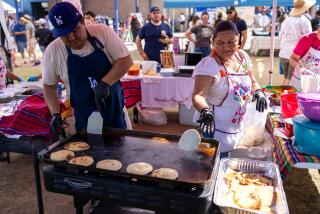Resettlement Planned for Thousands : Salvador Builds Fortified Towns to Block Guerrillas
HACIENDA ACHICHILCO, El Salvador — The government is taking the first steps to implement an ambitious plan to resettle thousands of homeless citizens in communities fortified against guerrilla penetration.
Called Project 1,000, the plan envisages creation of villages on abandoned rural land. The pilot site for the project is here in Hacienda Achichilco, a hilltop community of cinder-block shacks.
Along with home construction, education and health projects, government officials propose an extension of a controversial civil defense program aimed at engaging civilians in the country’s five-year-old civil war.
But even at this model community, the new residents have refused to take up arms for civil defense, although, at least theoretically, such a move would help keep guerrillas from stealing their crops or recruiting youths.
The military wants the farmers to be armed and to patrol the perimeters of their cooperative farm day and night, taking the burden of static security off the armed forces. Theoretically, such vigilance would cut guerrillas off from food supplies and from refuge in the countryside.
The plans to enroll residents of the new villages in militias are reminiscent of the effort by the government of neighboring Guatemala to form armed civilian settlements where rebels dare not tread. Some people have even compared Project 1,000 to U.S.-supported efforts in Vietnam beginning in 1962 to form “strategic hamlets” free from guerrilla influence.
Although efforts to arm rural civilians and to engage them in their own defense constitute a basic tactic in anti-guerrilla warfare, they have met with resistance in El Salvador. Past efforts at hometown civil defense here have proved more dangerous for participants than for the better-trained guerrillas. Innocent citizens have often been the targets of abuse by gun-toting amateur security guards.
With neither civil defense nor significant military support from locally based regular troops, Achichilco is floundering. Land lies idle because the farmers fear that their crops will be destroyed by one side or the other.
“Of course there are problems. But little by little, we hope to convince the population to take up arms for their self-defense,” said Col. Luis Amaya, who heads the country’s war reconstruction agency. “But everything will be voluntary.”
Project 1,000 gets its name from the plan’s goal, which is to invigorate a mythical 1,000 of El Salvador’s poorest communities through resettlement. Plans for the project were drawn up last summer by government officials as a means of alleviating El Salvador’s burden of providing for a growing number of homeless people.
An estimated 500,000 Salvadorans have fled their homes because of the long and often-brutal fighting.
“We decided something had to be done,” Amaya said. “The country cannot afford to have so many people without home or work.”
The plan is the latest indication that the Salvadoran armed forces believe that the war against leftist guerrillas is going well. However, past projects aimed at encouraging refugees to return to abandoned land have failed because of a lack of security for residents.
The cost for Project 1,000 has been variously estimated at between $70 million and $100 million, and the government is expected to ask European and Latin American nations to donate funds for the effort this year. The United States is expected to be the project’s biggest financial booster.
Officials from the U.S. Agency for International Development say they are keeping their distance from the Salvadoran program. However, AID has begun a survey of refugees to see if they would like to reside in the new villages.
“We are, of course, interested in anything that would help the displaced people,” an AID spokesman said. “But we have absolutely nothing to do with Project 1,000.”
At present, refugees live in a variety of camps. Some of the facilities are organized and administered by refugee aid groups; others simply have sprouted on vacant lots and often have neither water nor sanitation facilities. Jobs are scarce.
Achichilco is nestled at the base of the Chichontepec Volcano, two miles south of the city of San Vicente. The farm once belonged to a large landowner who abandoned it in 1979. The government bought the land and formed a cooperative of 60 former tenant families.
For a while, the farming went well. Harvests of rice, corn, beans and sugar were sufficient to keep pace with the large payments due on the mortgage on the land.
Local guerrillas, learning that the co-op’s members, under pressure from local military commanders, had formed a civil defense unit, struck several times at the cooperative. They burned the main ranch house, blew up the co-op’s only tractor and stole crops.
“Let’s just say we couldn’t stand the tension,” said Alfonso Mejia, 32, secretary of the cooperative. “The army came in once and got ambushed. That persuaded everyone to leave.”
The residents fled mainly to San Vicente, but some traveled to San Salvador and beyond. The fields were soon choked with weeds.
In 1982, however, a few farmers returned to Achichilco. Armed by military commanders and told to defend themselves, the daring peasants were able to grow only a small sugar crop and corn and beans for their own use.
San Vicente province has previously been the target of government efforts to build militia units, and many Salvadorans complain that, even though the program is supposed to be voluntary, they face jail for refusal to participate.
The project at Achichilco is the first attempt to create a village and civil defense system from the ground up, with refugees as the population base.
Last year, the government decided to try to attract new residents to the co-op in hopes that added hands would increase agricultural production. The model community was born. Sixty cinder-block homes began to rise on a barren hillside. A pump brought water to doorstep spigots.
Neither medical facilities nor schools have so far accompanied the housing. Still, when word spread to San Vicente that some homes were available, scores of refugees applied. Former residents of the nearly abandoned area were given first choice.
“My aunt told me about the new houses. They are much better than the shack we had in San Vicente. There, the walls were of plastic paper,” said Josefina Antonio, who brought her six children to live in a small house here.
Since the first residents arrived last summer, the plan has gone awry in several ways.
For one thing, the new residents have decided not to form a civil defense corps. Too dangerous, they say.
The army cannot guarantee freedom from rebel attack, so co-op members feel able to cultivate only a small portion of the land they own.
In the meantime, old debts remain unpaid. An installment loan to the cooperative of more than $50,000 is due to be repaid by 1988. But the cooperative earned only $5,000 for this year’s sugar crop.
With little opportunity to work, the residents have reverted to dependence on government handouts. They still receive monthly rations of corn, cooking oil, sugar and rice from the government.
The main difference that Project 1,000 has made in their lives is that instead of living in squalid and flimsy roadside shacks, they have block houses on an airy hilltop.
Guerrillas still move through the property, and residents say that to stop them would mean trouble. But the government and military say there will be even more trouble if refugees here and in other places like this in the future refuse to assist in the nation’s defense effort.
More to Read
Sign up for Essential California
The most important California stories and recommendations in your inbox every morning.
You may occasionally receive promotional content from the Los Angeles Times.










